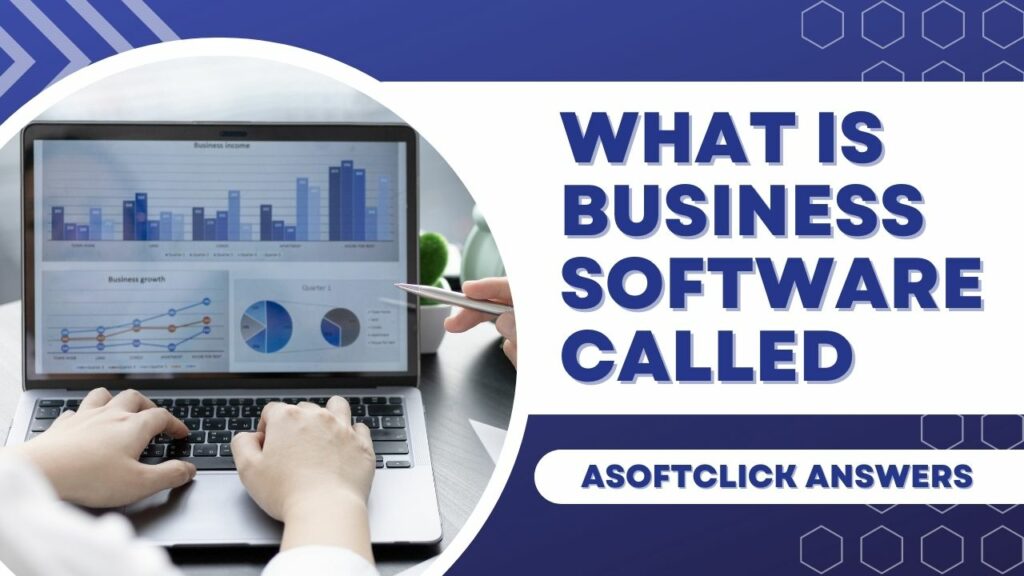 Business software is a tool that helps companies run better. Knowing their names is important because it helps people work together and make smart choices. The right software can make businesses faster and more competitive. In this article, we will answer your question, “What is business software called?”
Business software is a tool that helps companies run better. Knowing their names is important because it helps people work together and make smart choices. The right software can make businesses faster and more competitive. In this article, we will answer your question, “What is business software called?”
What is business software?
Business software refers to a bunch of computer programs that help companies manage and improve their work. These programs do different tasks like keeping track of customers, handling money, organizing projects, and more. They make work smoother by letting people do things on computers that would otherwise take a lot of time and effort.
Knowing what business software is called is like knowing the names of tools in a toolbox. When people know the names of these software tools, they can talk about them easily, share ideas, and work together better. It’s like knowing which tool to use for a specific job – using the right software helps businesses grow faster and do things smarter.
You might also like: Top 7 Best Office Applications in 2023
Key features of Business Software

Business software has special features that help companies do their jobs better. It can keep track of important information, like customers’ details. It also helps with managing money, like keeping records of what’s spent and earned. Business software can organize tasks and projects, making sure everyone knows what needs to be done. It’s like having a helpful friend for businesses to stay organized and work smoothly.
- Organizing Information. Business software helps keep important information in one place, like customer names and orders
- Financial Management. It helps track money, like making invoices and keeping records of expenses and profits.
- Project Planning. Business software can create plans for tasks and projects, showing who does what and when.
- Communication. It allows people in a company to easily share messages and updates with each other.
- Data Analysis. Business software can turn lots of information into helpful charts and graphs for better decision-making.
- Automation. It can do repetitive tasks automatically, like sending reminders or updating inventory.
- Security. Business software helps protect sensitive information from being accessed by the wrong people.
- Customer Management. It keeps track of customer interactions and helps provide better service.
- Collaboration. Business software enables people to work together on the same documents and projects.
- Reporting. It generates reports that show how the business is doing, helping in making informed choices.
Deployment options

1. On-Premises Deployment
In this approach, the business installs the software on its own servers and infrastructure, usually within its premises. This provides maximum control over the software’s configuration and data storage. However, it requires dedicated IT resources to manage, update, and maintain the software, including hardware and security measures. On-premises deployment is suitable when data security and compliance are paramount, but it can be more resource-intensive in terms of both time and cost.
2. Cloud-Based Deployment (SaaS – Software as a Service)
Cloud-based deployment involves hosting the software on a third-party provider’s servers and delivering it over the Internet. Users access the software through web browsers, and the provider handles maintenance, updates, and security. This approach is cost-effective as it eliminates the need for extensive infrastructure and IT maintenance. It also offers scalability, allowing businesses to adjust resources as needed. SaaS is particularly advantageous for small to medium-sized businesses that want quick access to powerful software without the IT overhead.
3. Hybrid Deployment
Hybrid deployment combines on-premises and cloud-based solutions. It allows businesses to keep sensitive data on their own servers while utilizing the cloud for other aspects of the software. This offers flexibility, enabling companies to scale resources as required and maintain control over certain data. Hybrid deployment is often chosen when a business has legacy systems they want to integrate with newer cloud-based solutions.
4. Containerization
Containerization involves packaging software, along with its dependencies and configurations, into a single unit called a container. Containers can run consistently across different environments, ensuring that software behaves the same way in the development, testing, and production stages. This approach simplifies deployment, improves scalability, and enhances consistency. Docker is a well-known technology for containerization.
5. Platform as a Service (PaaS)
PaaS provides a platform and environment for developers to build, deploy, and manage applications without worrying about the underlying infrastructure. Developers focus on coding and functionality, while the PaaS provider handles tasks like hardware provisioning, operating system updates, and network management. PaaS accelerates the development process and allows businesses to bring applications to market faster.
6. Mobile Deployment
Some business software is designed specifically for mobile devices, like smartphones and tablets. These applications can be distributed through app stores (such as Apple App Store or Google Play Store) or deployed internally within an organization. Mobile deployment is ideal for businesses that require employees to access and use software while on the move or working remotely.
7. Desktop Deployment
Traditional software applications that run on individual computers are still common. These are installed directly on a user’s desktop or laptop and function independently of the internet. While this approach may offer more control over data, it can be less flexible in terms of collaboration and remote access compared to cloud-based alternatives.
8. Managed Services
With managed services, a third-party provider takes care of deploying, maintaining, and managing the software for the business. This is especially useful for organizations that lack the expertise or resources to manage complex software systems themselves. Managed services can cover a wide range of tasks, from initial setup to ongoing monitoring and support.
9. Virtualization
Virtualization involves creating virtual instances of software within a single physical server. It optimizes resource utilization and can lead to cost savings by consolidating multiple software systems onto a single piece of hardware. Virtualization is often used in data centers to improve efficiency and scalability.
10. Open Source Deployment
Open-source software can be deployed on-premises or in the cloud. It offers the advantage of customization since the source code is accessible and modifiable. Businesses can tailor the software to fit their specific needs. However, open-source solutions may require a higher level of technical expertise for implementation and ongoing maintenance.
Each deployment option comes with its own set of benefits and considerations. The choice of deployment method depends on factors such as the organization’s infrastructure, security requirements, budget constraints, scalability needs, and the nature of the software being deployed. Careful consideration of these factors helps ensure that the selected deployment approach aligns with the organization’s goals and operational needs.
You might also like: What are Five 5 Examples of System Software?
What is business software called?

Businesses have different ways to set up their software. Some put it on their own computers and servers (On-Premises), which gives them full control but needs more management. Others use software on the internet (Cloud-Based), so they don’t worry about running it, and it’s accessible from anywhere. A mix of both is Hybrid, where important data is kept in-house, and other things are online for flexibility.
There are more ways too. Containers bundle software neatly, so it works consistently no matter where you place it. Managed Services mean someone else takes care of the software’s technical parts, good if the business doesn’t want to handle it all. For mobile devices like phones and tablets, there’s software designed just for them (Mobile Deployment). Choosing the right way depends on how much control, maintenance, and flexibility a business wants.
What are the five basic business software?
These are the basic types of business software that form the foundation for managing various aspects of a company’s operations.
- Accounting Software. This helps businesses manage financial tasks like recording transactions, generating invoices, tracking expenses, and preparing financial statements.
- Customer Relationship Management (CRM) Software. CRM software helps manage interactions with customers, tracking their information, purchase history, and communication to enhance customer service and retention.
- Project Management Software. This software helps plan, organize, and track tasks, timelines, and resources for projects, ensuring efficient collaboration and completion.
- Word Processing Software. Essential for creating and editing documents, this software allows businesses to write letters, reports, and other written materials.
- Spreadsheet Software. Spreadsheet programs enable businesses to perform calculations, create budgets, analyze data, and present information visually through tables and charts.
You might also like: Top 7 Common Types of Business Software
What software do most businesses use?
Most businesses use a combination of software tools to meet their specific needs, but there are several types of software that are commonly used across industries:
- Office Suites. Software like Microsoft Office or Google Workspace (formerly G Suite) includes word processing, spreadsheet, presentation, and email applications that are widely used for communication, documentation, and collaboration.
- Accounting Software. Many businesses use accounting software such as QuickBooks, Xero, or FreshBooks to manage their finances, track expenses, handle invoices, and generate financial reports.
- Customer Relationship Management (CRM) Software. Tools like Salesforce, HubSpot, or Zoho CRM help companies organize and manage customer interactions, sales leads, and marketing campaigns.
- Project Management Software. Popular options like Asana, Trello, or Microsoft Project help businesses plan, track, and collaborate on projects, ensuring tasks are completed on time and within budget.
- Communication and Collaboration Tools. Slack, Microsoft Teams, and Zoom are commonly used for real-time communication, video conferencing, and team collaboration, especially in remote work environments.
You might also like: What is a Management System Software?
Conclusion: What is business software called?
Business software, often referred to as application software for businesses, encompasses a range of specialized computer programs designed to streamline and enhance various aspects of organizational operations. These software tools, including customer relationship management (CRM), enterprise resource planning (ERP), project management, and accounting software, enable businesses to efficiently manage data, automate processes, and improve decision-making. Understanding the names and functions of specific business software is crucial for effective communication, collaboration, and strategic planning within a company, facilitating improved efficiency, growth, and competitiveness in the modern business landscape.
Now that we’ve answered your question, “What is business software called,” you should be able to utilize them for your business.





